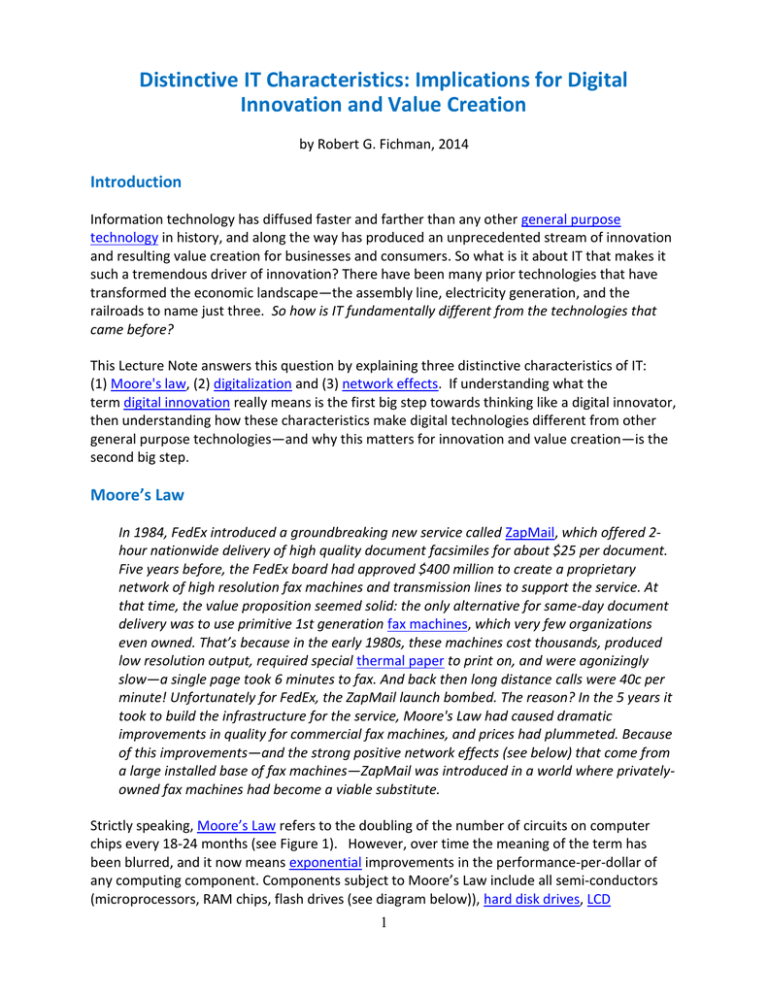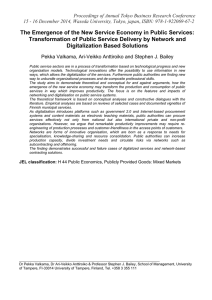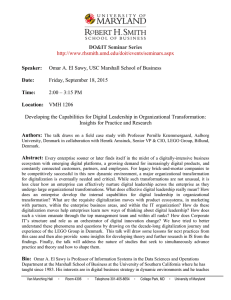Distinctive IT Characteristics
advertisement

Distinctive IT Characteristics: Implications for Digital Innovation and Value Creation by Robert G. Fichman, 2014 Introduction Information technology has diffused faster and farther than any other general purpose technology in history, and along the way has produced an unprecedented stream of innovation and resulting value creation for businesses and consumers. So what is it about IT that makes it such a tremendous driver of innovation? There have been many prior technologies that have transformed the economic landscape—the assembly line, electricity generation, and the railroads to name just three. So how is IT fundamentally different from the technologies that came before? This Lecture Note answers this question by explaining three distinctive characteristics of IT: (1) Moore's law, (2) digitalization and (3) network effects. If understanding what the term digital innovation really means is the first big step towards thinking like a digital innovator, then understanding how these characteristics make digital technologies different from other general purpose technologies—and why this matters for innovation and value creation—is the second big step. Moore’s Law In 1984, FedEx introduced a groundbreaking new service called ZapMail, which offered 2hour nationwide delivery of high quality document facsimiles for about $25 per document. Five years before, the FedEx board had approved $400 million to create a proprietary network of high resolution fax machines and transmission lines to support the service. At that time, the value proposition seemed solid: the only alternative for same-day document delivery was to use primitive 1st generation fax machines, which very few organizations even owned. That’s because in the early 1980s, these machines cost thousands, produced low resolution output, required special thermal paper to print on, and were agonizingly slow—a single page took 6 minutes to fax. And back then long distance calls were 40c per minute! Unfortunately for FedEx, the ZapMail launch bombed. The reason? In the 5 years it took to build the infrastructure for the service, Moore's Law had caused dramatic improvements in quality for commercial fax machines, and prices had plummeted. Because of this improvements—and the strong positive network effects (see below) that come from a large installed base of fax machines—ZapMail was introduced in a world where privatelyowned fax machines had become a viable substitute. Strictly speaking, Moore’s Law refers to the doubling of the number of circuits on computer chips every 18-24 months (see Figure 1). However, over time the meaning of the term has been blurred, and it now means exponential improvements in the performance-per-dollar of any computing component. Components subject to Moore’s Law include all semi-conductors (microprocessors, RAM chips, flash drives (see diagram below)), hard disk drives, LCD 1 monitors, and fiber-optic transmission equipment. All digital devices that incorporate these components (computers, iPods, smartphones, fax machines, etc.) also benefit from this exponential improvement process. That’s why today’s iPod Touch costs about as much as the first digital music players introduced in the late 1990s, but holds 1000x as many songs, and also plays videos, runs apps, surfs the net, etc. Moore’s Law has been observed for close to 50 years now, and is expected to continue for at least 10 more. Source: Wikipedia Commons The most immediate result of Moore’s Law is, of course, tremendous value creation. The same products can be produced for rapidly decreasing cost (e.g., the cost of flash drives has dropped 10-fold in just few years) and with rapidly increasing performance—and most of that benefit goes to consumers. Also, innovative new products, services and business models are made possible that were not cost-effective before (e.g., high quality digital cameras, free social media sites). Why didn’t FedEx executives foresee the threat that Moore’s Law represented to their ZapMail business? It’s hard to know, but one likely reason is that exponential improvements aren’t that noticeable until the process has reached a certain threshold. When a technology is going from “awful” to “half as awful” to “one fourth as awful” that’s easy to overlook. But once a technology has finally crossed that threshold from “bad” to “pretty good,” situation shifts rapidly. The technology keeps right on getting twice as good every 18 months. When $300 digital music players went from 10 songs, to 20, to 40, that was nice for very early adopters, but 2 was not enough to change the relationship of average people to their music. But by the time the first iPod was launched it had become possible to put 1,000 songs on a pocket-sized device—basically a whole music library—and that changed everything. Digitalization In 1999, twenty years after FedEx gave the go ahead to the ill-fated ZapMail, Shawn Fanning, a Northeastern University undergrad, unleashed the music industry’s worst nightmare. Tired of using clunky search engines to find digital music files on the Internet, Fanning invented an easy-to-use peer-to-peer file sharing system called Napster. At the time hardly anyone had heard of MP3s, the first standard for compressed digital audio. But within a few years, free (and illegal) digital downloads had become the primary way many people got their music, and music CDs sales began an inexorable slide. Today it’s estimated that 16 songs are illegally traded for every legal music download at iTunes and other legitimate sites. Digitalization means taking content or processes that used to be primarily (or entirely) physical or analog and transforming them to be primarily (or entirely) digital. Let’s start by talking about digitizing content, which simply means taking content that used to be stored in traditional formats (e.g., LP records, cassette tapes), and instead storing it as digital data (i.e., 1’s and 0’s). So, instead of physical documents, 35mm film, LP records, and VHS movies, we now have digital documents (e.g., MS Word, Adobe), digital images (JPEGs), digital music (MP3s), and digital video (DVD, MPEG, TiVo).1 While digitalization is enabled by Moore’s law, it represents a potent force for innovation and value creation in its own right. The most obvious advantage is that digital files can be perfectly copied any number of times. And because of Moore’s law, the cost of storing and sharing those copies has dropped close to zero. One 3-megabyte digital song now consumes far less than one penny’s worth of hard drive space, and can be transmitted in seconds over the Internet for free. Today’s 16 gigabyte flash cards can hold several thousand high resolution pictures but cost about $10. Just as important, digitalization of content has led to digital convergence, which means we no longer need a different device (i.e., radio, TV, record player, tape player), to play each kind of content. Any digital device has the potential to handle any kind of digital content. All it needs is a way to read the content, and the right software to play it back. That’s why you can use the same smartphone to make calls, send emails, take photos, listen to music and watch videos— instead of carrying around a phone, a computer terminal, a camera, a music player and a video player everywhere you go. Digitalizationalso creates value by allowing content itself to ride Moore’s Law, making it ever cheaper to store and transmit. But digitalization does much more than this. It also allows content to be automatically analyzed and manipulated to correct errors or to improve quality. Even more important, digital content can be automatically searched, indexed and crossreferenced to improve availability and shareability. Napster did nothing to reduce the cost of 3 storing and transmitting music: what it did was make it easy to find. By making content easy to find and acquire, digitalization enables the economics of the Long Tail. The image at right depicts sales volumes (vertical axis) for set of titles (e.g., books) put in order from highest volume at the left) to lowest volume (to the right. The “Long Tail” is the yellow part of the curve. The Long Tail Source: Wikipedia Commons The Long Tail refers to the many thousands of worthy—but less popular—books, songs and movies that aren’t carried in stores, and aren’t shown in movie theaters or broadcast over the airwaves, because demand is too low to justify use of those channels. But digitalization (of content itself and of information about content) unleashes the value in the Long Tail. It becomes economical to offer content that interests only a small percentage of consumers. There’s virtually no limit to the number of titles that can be offered through online channels. While a Barnes & Noble store gets 100% of its sales from the 130,000 unique titles it carries, Amazon.com gets less than half of its book sales from its top 130,000 titles. That means over half of Amazon’s book sales come from satisfying demand that otherwise would likely go unfilled. While Blockbuster stores used to carry about 3,000 DVD titles, NetFlix.com now offers over 100,000. Although when people talk about digitalization they are usually talking about digitizing content, we can also think about digitizing processes. This means taking a process that a firm previously did manually or with physical machines, and turning part or all of that process over to computers or other digital devices. The main effect of digitizing processes, aside from the obvious efficiency gains, is to make them more flexible and tailorable. For example, in the past decade banks digitized the process of handling check images for all their internal processes. Instead of moving paper checks around, they scan the checks and move digital check images around. Once this is done, it’s easy to go the further step to let customers deposit checks by simply taking a picture of the check on their smartphones. In fact, much of the move towards self-service has been made possible by digitizing processes. Network Effects In 1984, Apple Computer was on top of the world. They had just introduced the revolutionary Apple Macintosh Computer, the first personal computer to have a graphical user interface and a computer mouse for input. Before long, the Mac had also pioneered 4 the concept of “plug and play” peripherals and multimedia support. But the Mac, despite its obvious technical superiority, never got more than a 10% market share. Apple stock went through major gyrations in the next decade, ending up about where it started. Meanwhile, the stalwarts of the PC world—Microsoft and Intel—saw their sales and profits go up 100fold in this same 10 years. By 1997, Apple was on the verge of bankruptcy. If not for $150 million cash infusion by none other than Bill Gates—and the return of Apple savior Steven Jobs to become CEO—the company would have almost certainly gone under. What happened to the original Apple Mac? Put simply, it lost out to another standard (IBM PC) that had much stronger network effects. Network effects means the benefit of technology use increase with the size of the community of other users. This leads to virtuous cycles of adoption where each round of adoption makes the technology even more attractive, which encourages more adoption in the next round, and so forth.2 When the Mac came along, the IBM PC standard already had a very large network and dominated the PC world. As a result, there was a much greater variety of software programs to buy, and those programs could be sold more cheaply. Also, the large network drove down the cost of components and peripherals for IBM standard PCs. So, for most people, the total value of joining the IBM PC network (i.e., inherent value plus network benefits), was larger than joining the small Mac network, despite the inherent superiority of the Mac. Network effects can come from many sources. One key source is direct interactions among users as they communicate and share data or other assets. These are called positive network externalities. Telephone networks provide a classic example. A telephone is of no use when there is no one to call, but as the number of telephone users increases, the value to you increases even though you have not paid any more for the phone. This is where the term “externality” comes from: it’s a benefit—or cost, in the case of negative externalities—that is external to the original transaction, i.e., your purchase of the phone. When you use MS Office, you benefit because it's easy to exchange documents with the huge network of other MS Office users. One way to represent value of network externalities is with Metcalfe’s Law, which states that the total value of a network is proportional to the number of links between network nodes (i.e., users), which grows as the square of the number of nodes. Positive network externalities are a consumer-side benefit the comes from going along with the crowd. There are equally important producer-side network effects, which drive down product costs and increase quality. For example, most technologies are subject to a learning curve, meaning that as the volume of production increases, the cost per unit falls. Products with a large network move down the learning curve faster. Also, many types of IT products (microprocessors, software) have very high fixed costs of development, and very low variable costs of production and distribution, meaning there are huge scale economies. A new PC operating system costs billions to develop. But after it’s developed, each copy costs next to nothing to produce and distribute. All the time Apple was trying to compete with Microsoft in the 1980s and 90s, it had the profound disadvantage of spreading its operating system development costs over only a few million Macs, while Microsoft was spreading its costs over 100 million Windows PCs. 5 Looking beyond individual producers, we often see entire ecosystems arise around dominant technologies like Windows. (An ecosystem consists of a core innovation plus a set of technologies, products and services that complement the core innovation.) A strong ecosystem means there will be better training classes and aids available in the market place; it will be easier to hire personnel that are already trained; and useful add-in products will tend to be developed first, and maybe only, for Windows. Strong network effects have several implications. The greater the number of people that use a product or standard, the more valuable it becomes to any individual user, and the more likely it is that people will choose to adopt it in the future. So, network effects tend to produce selfreinforcing virtuous cycles of adoption and “winner-take-all” outcomes, wherein one technology or standard eventually dominates. They also have a tendency towards three additional diffusion patterns: (1) standards wars (where two or more technologies compete for dominance), (2) path dependent technology trajectories (where the outcome depends on small, chance events early in the process) and (3) technology lock-in (where a standard cannot be over turned even when a better technology comes along). Let’s look a little closer at each of these three patterns. Standards wars abound in the IT world. Consider Windows vs. Apple Mac OS, Apple iPhone vs. Google Android, Internet Explorer vs. Mozilla vs. Chrome, Play-Station vs. xBox, and Blu-Ray vs. HD DVD to name just a few. A great example of path dependency is IBM’s decision back in 1980 to have Microsoft build the operating system (OS) for the IBM PC instead of IBM taking a few months to build the OS themselves (OSs weren’t all that complicated back then). Imagine how Microsoft’s fortunes, and the world of computing might have been different! Now, of course, most of the world has become locked-in to Windows as a standard OS, due to extremely high switching costs and other factors. Food for thought: Interestingly, the Mac OS has gained significant market share in recent years. To understand how is this possible requires a subtle understanding of network effects. Here are some issues to consider: What architectural changes has Apple taken to improve the scale economies for computers running the Mac OS? What has happened to the cost of computers in general? Have there been any changes in the patterns of how personal computers are used that could loosen the bonds of “lock-in,” not just for Windows, but for any personal computer OS? From an adopter perspective, patterns described above raise the stakes on technology evaluation, because it becomes especially important to pick the eventual winning technology or standard (or to at least preserve a migration path to the ultimate winner). From a supplier perspective, this increases the opportunity for genuine first mover advantages and can justify speculative investment to build a large adoption network fast. Witness the dominance of early movers on the Internet, such as eBay, Paypal and Amazon. They all become more valuable the more they are used (network effects); they all started from humble, almost accidental beginnings (path dependency); and now they all command great loyalty, in part due to cleverly built-in switching costs. 6 Putting it All Together: From Distinctive Characteristics to Transformational Impacts The overall effect of Moore’s Law, digitalization, and network effects—individually and in combination—has been to continually roll back the frontier on what is technically and economically feasible to accomplish with IT. As a result, IT has become the dominant driving force for innovation in processes, products and business models today, and we are reaching the point where most large organizations are well on the road to becoming so-called “digital enterprises” (i.e., enterprises where all information produced and consumed by key business processes are stored and made broadly available in digital form). The table below provides a short-hand way of understanding why and how these three characteristics of IT are transforming jobs, companies, markets and even entire industries. The right hand column shows chains of causation that summarizes how one or more distinctive IT characteristics produce, through a set of intervening processes or results, some important macro-level transformation. Table 1: Transformational Impacts of Moore’s Law, Digitalization and Network Effects for Innovation Summary Impact Chain of Influences Leading to an Transformational Impact 1. Industry transformation Moore’s Law & Digitalization => device and network convergence => destruction of tight couplings between service modes and underlying technologies => industry and market convergence; radical transformation of whole industries. 2. Distinctive diffusion dynamics Network effects => “critical mass” diffusion dynamics, path dependency, winner take all, lock-in => standards wars, risk of stranding. 3. More diverse products and services Moore’s Law & Digitalization => widespread diffusion of cheap digital infrastructures => increased ability to aggregate product demand through online channels + increased ability of consumers to find niche products suited to their tastes => greater diversity of products and services developed and offered (“Long Tail” effect). 4. More personalized products and services Digitalization => programmability, memorability, associability => greater personalization of novel processes, products and services. 5. Faster innovation cycles and processes Moore’s Law & Digitalization => dramatically lowered cost/increased ease of experimentation + complementary changes to innovation processes, structures, incentives => more rapid development and evolution of innovative processes and products. 6. Faster/ broader product diffusion Moore’s Law & Digitalization => rapid price/performance improvement of physical digital products; near zero cost of duplication and distribution of improvements for pure information products => accelerated emergence and faster/broader diffusion of new products and business models. 7 Summary Impact Chain of Influences Leading to an Implication or Impact 7. Product pricing and delivery flexibility Digitalization => near zero cost of duplication and distribution; digital rights management => intellectual property threats; increased control over how digital product are used, when and by whom (e.g., bundling, trials, “freemium” models); greater pricing flexibility (e.g., how much is charged, to whom, when, by what mechanism, and for what level of functionality) 8. New ways to market new products Moore’s Law & Digitalization & Network Effects => widespread diffusion of cheap digital infrastructures => new avenues for marketing and supporting new products (e.g., sponsored search and context-based ads, social medial marketing/online word-of-mouth) 9. Move to smart technologies and servitization Moore’s Law & Digitalization & Network Effects => increased feasibility of embedding digital sensors and processors in a wide range of everyday items and then connecting them up into an “Internet of things” => widespread emergence of “smart” technologies; accelerated move to servitization (converting products into services) and other kinds of new business models enabled by smart technologies. 10. Move to real-time question answering systems Moore’s Law & Digitalization => feasibility of understanding natural language questions and rapidly searching and then extracting knowledge from huge troves of structured and unstructured data => new organizational process and business models based on generalized real-time question answering systems. 11. Creation of analytics-driven digital innovation opportunities Digitalization => informating processes as they are automated => automatic capture of vast new stores of detailed data about processes => pervasive opportunities for analysis of all technology-mediated processes => increased opportunities for process and product/business model innovation. 12. Democratized innovation Moore’s Law & Digitalization => widespread diffusion of cheap digital infrastructures => increased ease of distributed collaboration and peer production => process and product innovation discovery and development becomes more open, democratized, and user-driven. Here’s some food for thought: Which company/technology today do you think best represents the best example of each chain of causation? Footnotes 1. An explanation of the nature and implications of digitalization of content is provided in Nicholas Negroponte’s Being Digital, Alfred E. Knope, 1995. Excerpts are available here.). 2. Shapiro and Varian’s classic book, Information Rules: A Strategic Guide to the Network Economy gives a thorough explanation of the sources and strategic implications of network effects.). 8





